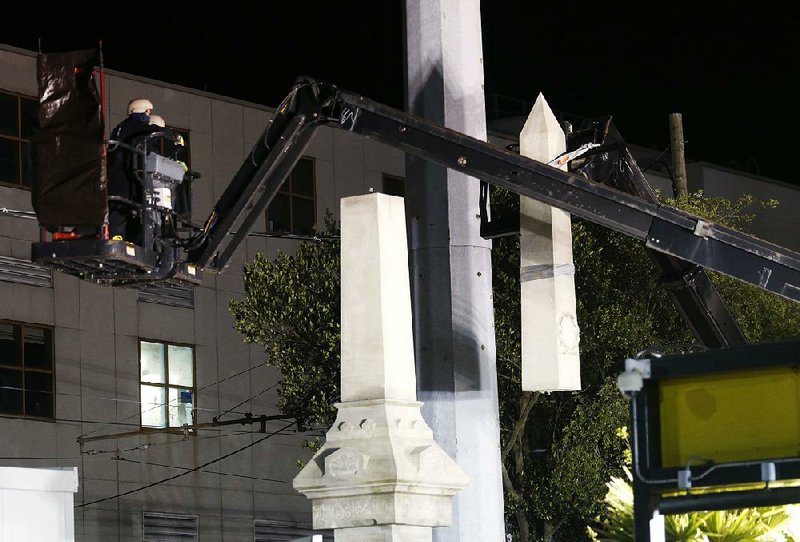On the same day that some Southern states were honoring their rebel heritage, masked workers in New Orleans dismantled a monument to that past -- chunk by chunk, under darkness and the protection of police snipers.
"We will no longer allow the Confederacy to literally be put on a pedestal," Mayor Mitch Landrieu, a Democrat, said after a 19th-century obelisk honoring what the mayor called "white supremacists" was taken down early Monday.
The Battle of Liberty Place monument, which honors members of the Crescent City White League who died trying to overthrow the New Orleans government after the Civil War, was the first of four statues linked to the Confederacy that are set to be torn down in New Orleans.
"The statue was put up to honor the killing of police officers by white supremacists," Landrieu said. "Of the four that we will move, this statue is perhaps the most blatant affront to the values that make America and New Orleans strong today."
Citing safety concerns, the mayor would not disclose exactly when the other monuments would be taken down, except to say that the removals will be done at night to avoid trouble.
Landrieu said "intimidation and threats by people who don't want the statues down" prompted him to order the monument removed before sunrise, without prior announcement, on the same day that some other states celebrate Confederate Memorial Day.
After a small group of protesters dispersed about 1:30 a.m., police officers barricaded surrounding streets and snipers took position on a rooftop above the statue, according to the Times-Picayune. By 3 a.m., workers were drilling into the obelisk's stonework, and by dawn the Liberty Place monument had been trucked away in pieces.
Contractors wore face masks, helmets and what one reporter described at a news conference the next morning as "militarylike bulletproof vests." Landrieu said the workers were disguised for their protection.
There was no sign of threats the next morning, although a New Orleans group called the Monumental Task Committee condemned the operation.
"This secretive removal under the cloak of darkness, outside of the public bid, masked contractors, and using unidentified money wreaks of atrocious government," the group's president said in a statement. "People across Louisiana should be concerned over what will disappear next."
The mayor called the Liberty Place monument the most offensive of the city's tributes to "the lost cause of the Confederacy."
It and three other memorials to rebel leaders -- Confederate President Jefferson Davis and Gens. Robert E. Lee and P.G.T. Beauregard -- were ordered removed in 2015, after city meetings that the Times-Picayune described as rowdy and sometimes racially divided.
There has been division over Confederate memorials in many Southern states, which have been wrestling with how to remember their Civil War legacies after a self-described white supremacist massacred black churchgoers in South Carolina two years ago.
The deadly church shooting led to a backlash against Confederate imagery across the South, most notably when the rebel flag fell after 54 years outside the South Carolina statehouse.
The University of Mississippi took down its state flag because it includes the Confederate emblem.
Charlottesville, Va., was sued in March by a group trying to stop a similar purge of Confederate imagery there.
The monument New Orleans took down Monday marks a battle that occurred several years after the Civil War's end in which white paramilitaries battled a mixed-race police force, causing deaths on both sides.
Sixteen White Leaguers, 13 members of the Metropolitan police force and six bystanders were among those killed in the bloody battle down Canal Street.
An inscription added in 1932 said the Yankees withdrew federal troops and "recognized white supremacy in the South" after the uprising. In 1993, those words were covered by a granite slab with a new inscription, saying the obelisk honors "Americans on both sides" who died and that the conflict "should teach us lessons for the future."
At a news conference Monday morning, Landrieu read out the names of police who died in the Battle of Liberty Place. He derided their opponents as a "cult" in a statement.
The monument was trucked off to storage, Landrieu said, and will be relocated later, perhaps to a museum. He promised to stick to plans to remove the other three Confederate statues.
"I very strongly believe that we're on the right side of history," the mayor said.
Information for this article was contributed by Avi Selk of The Washington Post and by Jesse J. Holland, Gerald Herbert and staff members of The Associated Press.
A Section on 04/25/2017
